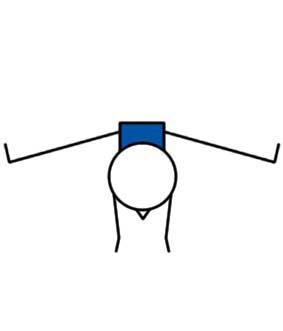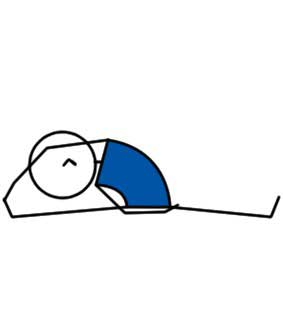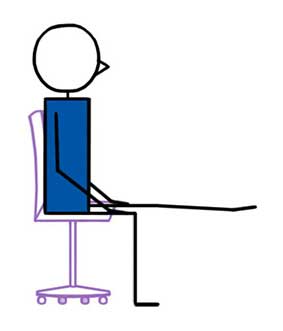
Ankle Bending
| Sanskrit Name: | Goolf Chakra |
|---|---|
| Similar Pose Names: | ankle stretch,ankle rotation |
| Category: | Seated & Floor |
| Share on: |
 Yoga Lesson Planner
Yoga Lesson Planner
 Pilates Lesson Planner
Pilates Lesson Planner
| Category: | Yoga Lesson Planner |
|---|---|
| Sub Category: | Seated & Floor |
| Types: | Pawanmuktasa, Seated, Seated & Floor |
| Anatomy: | Hamstrings, Middle Back, Psoas, Upper Back |
| Chakras: | Base, Crown Centre, Sacral Centre, Third Eye |
| Therapy: | Anxiety, Back Pain, Elderly People, Leg Congestion, Poor Posture |
| Drishti: | Tip Of Nose |
| Dosha: | Kapha, Pitta |
| Meridian Lines: | Spleen, Stomach |
Part I Toe Wiggles: Sit with legs extended. Both ankles together. Place both hands behind pelvis. Lean back. Look at feet. Wiggle toes back and forth. Part II Ankle Bending: Move ankles back and forth. Part III Ankle Rotations: Rotate right foot clockwise several times & then anticlockwise. Repeat with left foot.
Improve circulation through ankles and feet.
Click here for lots of FREE downloadable Yoga lesson plans.
Click here for lots of FREE downloadable Pilates lesson plans.
- 3rd Trimester
- Hatha - gentle
- 23rd and 24th April 2019
- Slow down yoga
- Slow down yoga
- Relax & Restore
- Slow Flow Tuesday
- Vernal Equanox-Detox
- Head to Toe
- 'May Day' Lesson Plan
- Seated & Floor
- Flow class - Focus on Feet
- Friday restorative yin
- Ask Genie1
- Chakra Yoga week 2
- calming Yin
- Wendy McNeil
- Beginners Yoga 9: Eye of the needle peak pose
- Connectivity
- RLS Week 1: Locust Peak Pose
- pregancy class 1
- yoga new term tuesdays
- yoga new term tuesdays
- chair and mat
- Pregnancy Home sequence handout (please work to your own level)
- support carers
- Ask Genie1
- Cavendish 29Jan 2019
- Cavendish 4 Feb 2019
- paying attention to your breathing
- Relax & Restore
- Core & Active Stretch (Light on Knees + Wrists)
- 7th and 8th May plus 14th and 15th May 2019
- knee strengtheners
- Seated and floor
- Chair 6, 9 breaths
- Connectivity
- seated and floor
- Relax & Restore
- 2019 Week 31
- A gentle time
- total session
- Paying Attention to our foundation - Basics of Standing poses + flow
- Flow 3.5 Weekly Theme (Ahimsa) "All things are our relatives; what we do to everything, we do to ourselves. All is really One." ~ Black Elk
- Beginners 6 week Course
- Friday 9.10 Pat 1.46
- Friday 9.10 Pat 1.46
- Gina 01/30/2020
- Tuesday 6.4 HPY 2.5
- Slow down restorative relaxation evening
- Tuesday 6.6 HPY 2.5
- Tuesday 6.7 HPY 2.5
- Friday 11.1 YSP 2.6
- Slow down restorative relaxation evening
- Vinyasas for home practice
- Diastasis Recti
- zoom 11
- Georgie Home Practice
- Georgie Home Practice Sequence
- Slow down restorative relaxation evening
- Relax & Restore
- Digestive healing
- Beginners Week 6
- Combined Chair/gentle floor Yoga for Seniors - Straps/blocks/blankets/eye pillows/bolsters
- Friday Gentle 6 Weeks
- Relax & Restore 2
- 32, Zoom
- Relax & Restore 2
- Gentle Yoga August
- AUGUST COOLING SESSION
- August Cooling Session
- AUGUST COOLING SESSION
- Gentle Yoga August
- Friday Gentle 6 Weeks
- Relax & Restore
- Friday Gentle 6 Weeks
- Yin Yang Week 1 of 6
- Dave's exercises
- Slow Flow
- Yin Yang Week 1 of 6
- Ask Genie2
- Yin Yang Week 1 of 6
- Gentle Yoga for Back and Hips - seated and floor -
- Yoga for your inner smile
- Yin Yang Week 1 of 6
- Yin Yang Week 1 of 6
- Relax & Restore 2
- Ask Genie1
- Extra postures for JG Nov 20
- Yin Yang Week 1 of 6
- online 12 Jan 2021
- Evening Yoga for Children (10 min)
- Gentle Yoga for Back and Hips - seated and floor -
- restorative
- Ask Genie1
- Strength and Resilience using awareness and inner teacher
- Yoga Therapy A
- Yin Yang Week 1 of 6
- Ask Genie1
- seated and twists
Ankle Bending Pose (a.k.a. ankle stretch or ankle rotation), is a simple pose that improves ankle mobility, flexibility, and strength. It involves rotating the ankle joint in circles, which releases tension, reduce stiffness, and increases blood circulation to the feet and ankles.
The Sanskrit name for Ankle Bending pose is “Goolf Chakra Asana” where “Goolf” means ankle and “Chakra” means wheel or circle, and “Asana” means pose.
In this post, we will explore the benefits, teaching tips, follow-up poses, and class themes related to Ankle Bending Pose, as well as delve into the anatomy of the ankle and how it functions in the body.
Ankle Bending Pose: 10 Teaching Tips
Here are 10 teaching tips for Ankle Bending Pose:
Teach the Sanskrit: Dandasana is pronounced: “DAHN-dah-suh-nuh”. The emphasis is on the first syllable, “DAHN”.
Explain The Benefits: Start by explaining the benefits of the pose to your students, and how it can help improve ankle flexibility, strength, and circulation.
Demonstrate Clearly: Demonstrate the pose slowly and clearly, breaking it down step by step to ensure that students understand the correct alignment and technique.
Warm Up The Ankles: Encourage your students to warm up their ankles before practising the Ankle Bending Pose, either by walking, rolling a tennis ball under their feet, or doing some ankle circles.
Maintain Good Posture: Remind your students to keep their spine straight and their shoulders relaxed while practising the pose.
Focus On The Breath: Instruct your students to take slow, deep breaths while practicing the pose, and to focus on their breath and the sensations in their ankles.
Don’t Compete With Others: Encourage your students to go at their own pace, and to look around at what the other students are doing.
Offer Modifications: Offer modifications and variations for students who may have difficulty with the pose, such as using a chair or a wall for support.
Practice On Both Ankles: Remind your students to practice the pose on both ankles and to hold each position for at least 30 seconds.
Encourage Regular Practice: Encourage your students to practice the Ankle Bending Pose regularly, and to incorporate it into their daily routine for maximum benefit.
Be Patient: Remind your students to be patient with themselves and to enjoy the process of exploring their ankle mobility and flexibility through this pose.
Ankle Bending Pose: 9 Yoga Class Theme Ideas
Here are some class themes that a yoga teacher could use for the Ankle Bending Pose:
Gratitude: Encourage students to express gratitude for their feet and ankles, and to honour the hard work that they do every day by practising this pose.
Grounding: Use the pose as a way to ground students and connect them to the earth, reminding them of the importance of a strong foundation.
Let Go: Encourage students to release tension in their ankles and feet, and to release any emotional baggage that may be weighing them down.
Strength and stability: Focus on the strength and stability that the pose can bring to the ankles and feet, and how this can translate into other areas of life.
Flexibility: Emphasize the importance of flexibility in both body and mind and how practising this pose can help cultivate greater flexibility and openness.
Balance: Use the pose as a way to explore balance, both physical and emotional, and to cultivate greater equilibrium in all aspects of life.
Grounding down to rise up: Connect the pose to the idea of grounding down in order to rise up, reminding students that strength and stability come from a strong foundation.
Little Things: The ankles are usually ignored even though they are rather important. So, encourage your students to take time for the “little thing” in life that can make a big difference.
Finding freedom: Use the pose as a way to explore freedom and mobility, and how this can translate into greater freedom in other areas of life.
Ankle Bending Pose: 5 Benefits
The Ankle Bending pose has five main benefits:
Improved flexibility: Improve the flexibility and range of motion in your ankles and feet, making it easier to perform other yoga poses and daily activities that require ankle mobility.
Stronger ankles: Strengthen the muscles, tendons, and ligaments around your ankles, reducing the risk of ankle injuries.
Better circulation: Improve blood circulation to the feet and ankles, reducing swelling and stiffness.
Stress relief: Release tension and stress in the ankles, feet, and lower legs, providing a calming effect on the body and mind.
Improved posture: Help improve your posture by correcting any imbalances or misalignments in the feet and ankles.
Ankle Bending Pose: 5 Variations
There are five main variations of the Ankle Bending pose:
Seated Ankle Bending: Sit comfortably with your legs stretched out in front of you. Bend your left knee and bring your left foot towards your body. Hold the left ankle with your left hand and rotate it back and forth. Repeat with your right ankle.
Standing Ankle Bending: Stand with your feet hip-width apart. Lift your left foot and rotate it in clockwise and anti-clockwise directions. Repeat the same with your right foot.
Reclining Ankle Bending: Lie down on your back with your legs stretched out in front of you. Bend your left knee and bring your left foot towards your body. Hold your left ankle with your left hand and rotate it in clockwise and anti-clockwise directions. Repeat the same with your right ankle.
Chair Ankle Bending: Sit on a chair with your feet flat on the ground. Lift your left foot and rotate it in clockwise and anti-clockwise directions. Repeat the same with your right foot.
One-Legged Ankle Bending: Stand on your left leg and lift your right foot off the ground. Rotate your right ankle in clockwise and anti-clockwise directions. Repeat the same with your left ankle while standing on your right leg.
These variations can help you target different areas of your ankle and feet and also make the pose more challenging or accessible depending on your level of practice.
Ankle Bending Pose: 10 Follow-up Poses Requiring Flexibility and Strength
Here are ten follow-up poses that require a flexible and strong ankle:
Downward Facing Dog (Adho Mukha Svanasana): This pose requires a strong and flexible ankle to keep the heels grounded and the weight evenly distributed between hands and feet.
Warrior I (Virabhadrasana I): This pose requires a strong and flexible ankle in the front leg to maintain balance and stability.
Triangle Pose (Trikonasana): This pose requires a flexible ankle in the front leg to maintain stability and balance.
Crescent Lunge (Anjaneyasana): This pose requires a flexible ankle in the front leg to maintain balance and stability.
Half Moon Pose (Ardha Chandrasana): This pose requires a strong and flexible ankle in the standing leg to maintain balance and stability.
Tree Pose (Vrksasana): This pose requires a strong and flexible ankle in the standing leg to maintain balance and stability.
Eagle Pose (Garudasana): This pose requires a flexible ankle in the standing leg to maintain balance and stability.
Extended Hand-To-Big-Toe Pose (Utthita Hasta Padangusthasana): This pose requires a flexible ankle in the standing leg to maintain balance and stability.
Boat Pose (Navasana): This pose requires a flexible ankle to maintain proper alignment and balance.
Camel Pose (Ustrasana): This pose requires a flexible ankle to maintain proper alignment and balance.
Ankle Anatomy: Using Visualization to Explain to Your Yoga Students
As a yoga teacher, it’s important to have an understanding of the anatomy of the ankle and how it functions in the body. By using visualization and imagery, we can help our students understand the importance of the ankle in their practice and in their daily lives.
The ankle joint is made up of three bones: the tibia, fibula, and talus.
The tibia and fibula are the bones of the lower leg, while the talus is the bone of the foot that sits between the tibia and fibula. The ankle joint is responsible for dorsiflexion (lifting the foot towards the shin) and plantarflexion (pointing the foot away from the shin). It also allows for inversion (turning the foot inward) and eversion (turning the foot outward).
Imagine that your ankle joint is like a hinge that connects your lower leg and foot. Just like a hinge, the ankle joint allows for movement in one direction (dorsiflexion and plantarflexion) but not in the other. The ligaments that surround the ankle joint help to stabilize the joint and prevent excessive movement.
Now, imagine that your ankle is like the foundation of a house. If the foundation is weak or unstable, the rest of the house is at risk of collapsing. Similarly, if the ankle joint is weak or unstable, it can lead to pain, injury, and dysfunction in other areas of the body, such as the knees, hips, and lower back.
In yoga, we often use the feet and ankles as a foundation for standing poses and balances. By cultivating strength, stability, and flexibility in the ankles, we can improve our balance and alignment in these poses, and reduce the risk of injury.






















